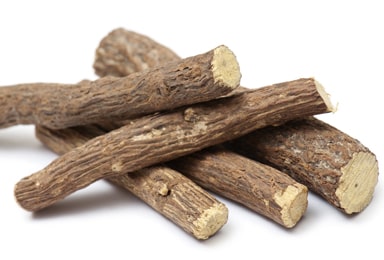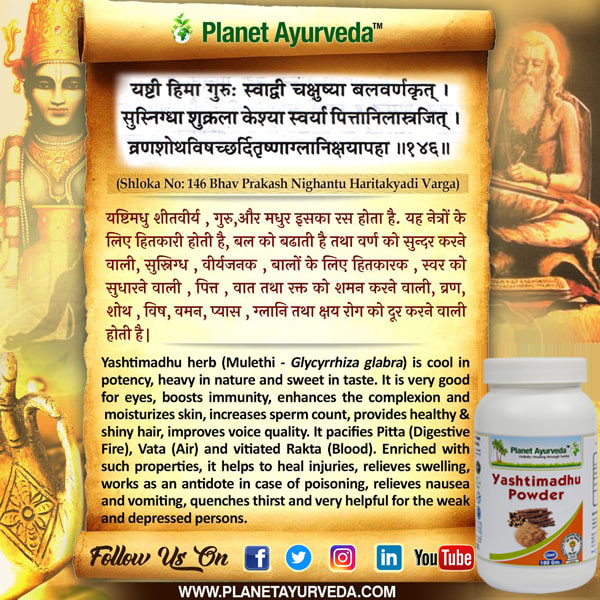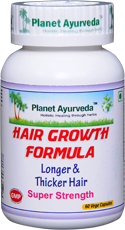Yashtimadhu, Licorice (Glycyrrhiza glabra) - Properties, Benefits & Dosage

Description of Plant
Yastimadhu (Glycyrrhiza glabra) is a perennial shrub, 6 feet in height with spikes bearing lilac-colored flowers with bean-like pods containing three or four seeds. Roots are long, wrinkled and brown in color. When outer skin of the shrub is removed there is a scaly yellow texture inside. From the basic root, secondary and tertiary roots originate. Leaves are conjoint, 70-150 mm long having 10-17 leaflets. Flowers are 8-12mm and pink to purple in color. Fruits are 20-30 mm, oblong pods and contain the 2-3 beans which are kidney-shaped.
General Information
Yastimadhu (Glycyrrhiza glabra) is commonly known as mulethi and mostly available in Indian Kitchen. Health benefits of Yastimadhu are described in Ayurveda many years ago. This herb has a Soothing effect on the throat and pharynx is good so the use of Yastimadhu is good for hoarseness of voice. This herb has the antacid, anti-ulcer genic, anti-inflammatory, anti-oxidants, anti-Alzheimer, anti-cancer, analgesic, immune modulator, anti-bacterial, anti-asthmatic, anti-arthritic and aphrodisiac properties. Roots of this herb contain 3.6% glycyrrhizin which is a yellow amorphous powder-asparagine, a glycoside isoliquirtin 2.2%, glucose 3.8%, starch, gum, mucilage, amorphous, sulphuric acid and metallic acids, calcium and magnesium salts. All these ingredients are packed with healing properties for the human body.
Classification
- Kingdom: Plantae
- Order: Fabales
- Family: Fabaceae
- Genus: Glycyrrhiza
Habitat
Yastimadhu is the native to Southeastern Europe and cultivated in most of Europe. It is grown best in the hot, dry and sunny climates with yearly low rainfall. Whereas adequate soil moisture is necessary for its growth and development.
Names
- Latin Name - Glycyrrhiza glabra
- English name - Licorice/Liquorice
- Hindi name - Mulethi, Jethimadhu
- Tamil and Telugu name - Atimadhuram, Irattimadhuram
- Hindi name - Muleti, Jetimadhu
- Kannada name - Atimadhura, Jeshtamadhu
- Telugu name - Yashtimadhukam
- Bengali name - Yashtimadhu
- Marathi name - Jeshtimadh
- Gujarati name - Jethimadh
CLASSICAL REFERENCE

Ayurvedic Properties
| Hindi / Sanskrit | English | ||
| Rasa | Madhura | Taste | Sweet |
| Guna | Guru, Pichilam | Physical Property | Sticky, Heavy |
| Virya | Sheeta | Potency | Cold |
| Vipaka | Madhura | Metabolic Property (After Digestion) | Sweet |
Effects on Doshas
It balances vata and pitta doshas.
| Charak Samhita | Sushrut Samhita | Sushrut Samhita |
|
|
|
Ancient Verse about Glycyrrhiza Glabra

Bhavprakash nighantu edition of 1998: verse 145-146, page no-65-66.
Yastimadhu, Yastimadhuk, Clitmak are names of mulethi. There is another type which is found in water. It is called as madhulika. It is cold in potency, heavy with a sweet taste. It is good for eyes, provides strength, improves complexion and enhances the quality of semen in the body. It is good for voice and hair. It manages pitta, vata, inflammation, wounds, vomiting, thirst and weakness.
References
The Bhavprakash nighantu with elaborated Hindi commentary by Padmashri prof. K.C. Chunekar, edited by Dr. G.S. Pandey: verse 145-146, edition of 1998: page no- 65-66.
Practical uses of Glycyrrhiza Glabra
- It is known to be an effective herb to resolve the respiratory complications. It acts as the wonderful emollient and it has the soothing effects on the throat as well as pharynx. Hence the use of this herb is quite good in the treatment of a cough, hoarseness of voice, chest congestion, sore throat, bronchitis, chronic bronchitis, and whooping cough. This herb helps to boost up the immune system and plays an important role in the treatment of asthma and various allergic reactions in the body.
- Roots of this herb support the good health of digestive system. This herb helps to lower down the acid levels in intestine. It is quite good to manage the problem of the indigestion and heartburn. Hence the use of this herb is quite effective in the treatment of gastrointestinal disorders like Irritable Bowel Syndrome (IBS), duodenal ulcers, peptic ulcers, and gastritis.
- This herb supports the good health of the liver and also enhances the bile secretion. Moreover, this herb helps to lower the cholesterol levels in the body too.
- This herb is good for the treatment of hypothyroidism. It helps to increase the secretion of thyroid hormones. Furthermore, this herb also helps to manage the hormonal imbalances.
- Roost of this herb contains a substance which prevents the conversion of testosterone into dihydrotestosterone. Dihydrotestosterone is the hormone which stimulates cell division in the male prostate gland. Hence this herb is quite good to reduce the size of the prostate gland and also helps to manage the symptoms associated with benign enlargement of the prostate.
- This herb is packed with anti-microbial activities. Hence it boosts up the body's immune system. It also increases the body's ability to fight against the various viral and bacterial infections. Anti-fungal properties of this herbs are quite good in the treatment of athlete's foot.
Parts Used
Roots
Dosage
1 to 4 grams.
Use of Glycyrrhiza Glabra in Ayurvedic Products of Planet Ayurveda
1. Praanrakshak Churna
Praanrakshak churna is an amazing formulation of Planet Ayurveda. Yastimadhu is used in the formulation of this herbal product. This herbal product treats respiratory complications like asthma, allergy, bronchitis and whooping cough.
2. Hair Growth Formula
This herb is also used in the formulation of hair growth formula. These capsules are good for hair fall, which makes the hair strong and also prevents them from premature graying.





